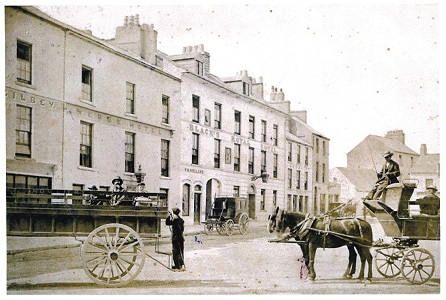BIANCONI IN GALWAY

by Tom Kenny
Charles Bianconi is generally regarded as the man who put Ireland on wheels. He developed a network of horse-drawn carriages that became Ireland’s first integrated transport system, building on the existing mail roads and coach roads that were already there. There was a general tax on coaches at the time which precluded the middle classes from using theirs, and a relatively peaceful period after the battle of Waterloo meant that a great many horses, bred for the army, became cheap on the market. His system offered connections with various termini, his prices were cheap and so he was well patronised, in spite of the discomfort felt by passengers. Often, when going up a hill, some passengers would alight to make the carriage lighter for the horses.
Weather was an important factor in the journey. A Prussian historian was the only person on board on one of those trips who had an umbrella. “The two young girls crouched down at our feet while the other four moved their faces so close to the shaft of the umbrella that their noses were almost touching. The old woman rested her head on my right shoulder while the gentleman on my right rested his head on my left shoulder. Through this ordeal by water, we had, within a short time become friends and acquaintances and I received much praise for my considerations and humanity”.
Galway became a hub for Bianconi, the mail coach came regularly from Dublin, there were connections to Castlebar, Tuam, Gort and further afield. The Galway-Clifden service started in 1837 with one car going each way every day. The car would leave Galway at 9am and arrive in Clifden at 7pm. The fare was 7/6d which seems expensive but it took you 49 miles quicker than any other system. It was the very last Bianconi service to continue running and was still in operation when the Galway-Clifden railway opened in 1895. Within a couple of weeks it had ceased, bringing to an end a transport system that had operated over most of the country for 78 years.
In the early 1850s, those who occupied this side of the Square were Walter Burke, John Harrison, John Wade, Robert Black, Charles Bianconi, Charles Bianconi, John Kilroy, Thomas Stokes, Charles Bianconi, and the final building was vacant. It is interesting that Charles Bianconi occupied three of the buildings, possibly on a lease or rent basis. I am not sure which buildings exactly he occupied.
Our photograph was taken c.1865-70 but we cannot see the Bianconi name anywhere. We can see two Bianconi cars though. The one on the right would carry about a dozen passengers, the one on the left would carry around twenty people. The building on the left was occupied by W, & A. Gilbey who were drinks distributors. They later moved premises around the corner to William Street.
Next door was Webb’s Hotel, built in 1810 and originally known as the Clanricarde Arms. The name was later changed to Kilroy’s Hotel, then Murphy’s until it was taken over by Joe Delaney and he changed the name to the Imperial Hotel. It has been known as that ever since and is probably the oldest hotel in Galway.
To the right of that was Black’s Royal Hotel. The ground floor section nearest Webb’s Hotel was a small unit which housed P.M. Holland’s outfitting establishment. Beside that you can see a half-open large arch through which was a right of way that led down to Eglinton Street. Black’s Saddlery was next and beside that was the entrance to the hotel. which waseventually taken over by Mrs. Webb (from next door) in 1867 and became known as Mack’s Hotel. In 1909, Miss Dunn was the proprietor and she eventually sold it to J.T. Costelloe. He, in turn sold it in 1952 when it was demolished and completely rebuilt as Woolworths.
Next to that was Lenihan’s, Tea, Wine and Spirit Merchants. Their high-class grocery opened in 1864, imported lots of exotic foods and was contracted by The Galway Hospital and the Galway Union. The family eventually converted it into a pub and restaurant which became known as The Tavern, which was the ‘in place’ in town for many years.
The single-story building at the end may well have been stables used for Mr. Bianconi’s horses.
This photograph is shown courtesy The National Library.
.png)